Everyday Designer Article: Freelance to permanent and back again
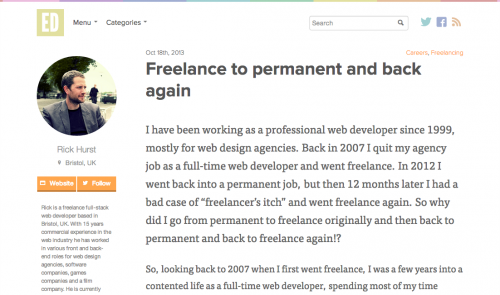
Earlier this month I wrote an article for Everyday Designer talking about my experiences about my experience of working as both freelance and permanent web developer.
Rick Hurst Full-Stack Developer in Bristol, UK
Menu
Earlier this month I wrote an article for Everyday Designer talking about my experiences about my experience of working as both freelance and permanent web developer.
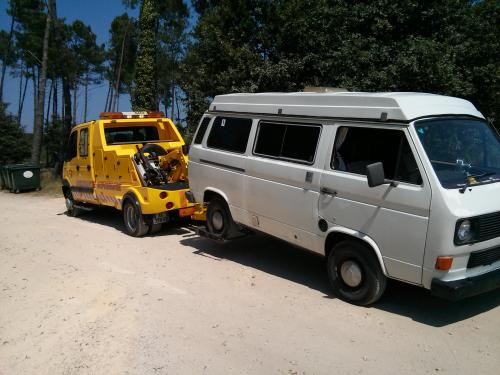
Ok after a productive start to the blog this year, i’ve failed to post since the start of the summer. I’m going to blame it mostly on my camper van, both literally spending time working on it and camping in it with my family, and also generally all my blogging effort has gone into my “camper van things” blog. I’ve had a fantastic summer, worked less than I probably should have, but now getting back to work (and saving up for some more summer adventures next year!).
So to catch up – i’m now freelancing more or less full-time back at Potato, working on some interesting stuff, notably cutting my teeth with AngularJs framework, which i’ve enjoyed so far. My initial observations are that it is significantly different to Backbone/Marionette that there is no confusion over what technology i’m using, it allows you to be productive very quickly and that it litters your markup with non-standard attributes. The latter may upset purists, but otherwise it gets the thumbs up from me. If you’re interested in learning AngularJs, a good place to start would be the tutorial.
Just stumbled across this blog about this stateside couple living and working on the road in their VW Vanagon (T25/T3 to us Brits). I’d love to be on the road again with my family, earning a living doing web stuff like I did for a bit in 2010 – probably won’t get the chance again until next summer now, so it’s great to live vicariously through other peoples’ stories!
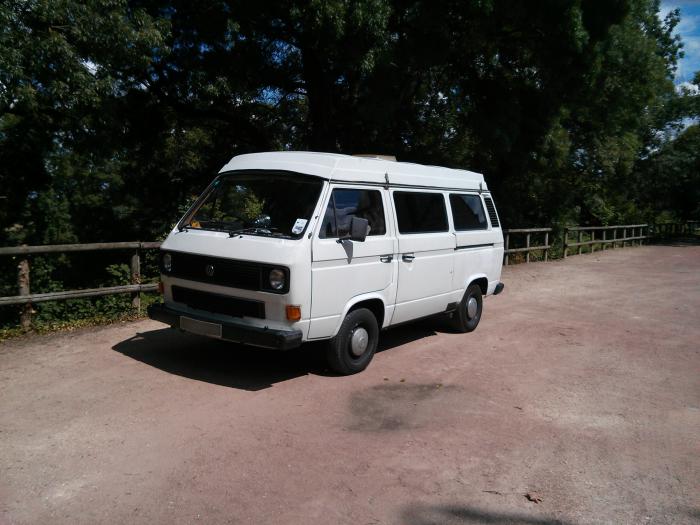
It’s nearly a year since we picked up our VW T25 camper. In that time, we’ve:-
I’ve also spent an unhealthy amount of time on the T25/T3 forums and Facebook groups enjoying reading about what adventures other people have been having with their vans and what they’ve been doing to them. One thing that is clear is that it is possible to spend a massive amount of cash improving a T25, from professional bodywork restorations, suspension mods and massive alloy wheels to powerful subaru or tdi engine replacements.
Personally I’ve decided that I need to rein things in, and concentrate just on keeping our bus roadworthy and ready for more adventures. I have a list of things that need sorting before I would be happy to take Rocky on another overseas trip. The fuel lines and the fuel tank breathers need sorting out, but also it looks like I need to consider an engine rebuild or another engine swap, as the 1.9 engine I had put in, although it runs brilliantly, is using an unsustainable amount of oil. The consensus seems to be that it is burning oil (basically using it as fuel) due to worn piston rings and/or bores.
I was hoping to get at least a couple of years out of this engine, but it hasn’t turned out that way. If I had the tools, skills and space to attempt an engine swap myself, I might have been tempted to try my luck with another old engine, but I really think its time to look at having the current engine dismantled, inspected and reconditioned/ remanufactured as needed which would hopefully add many more years life to it. Tempting as it is to save up for a Tdi conversion which (along with an appropriately geared gearbox) would make the van faster and more suited to motorway driving, i’ll settle for a reliable simple engine to plod along with in the slow lane, and put the cash saved towards more road trips.
However, our other “ongoing project” is a Victorian house, and the bus has diverted cash and attention away from the house over the last year, and this needs to be rectified. I’ll need to redo some of the aforementioned bodywork before the winter sets in, but other than that I’ll have to ignore him for a while, and concentrate on the house instead.
One thing i’m sure of though, is that despite the ongoing costs, we have had a lot of fun with this bus, and are really glad we bought it. Still looking forward to many adventures to come!
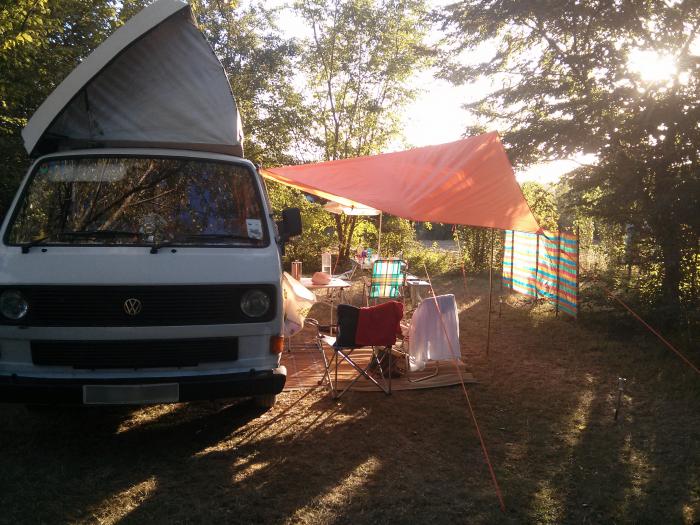
At the end of July, we headed off in an unprecedented UK heatwave to Portsmouth to catch a ferry to Santander in the north of Spain. Despite the cost of the ferry, we decided that for Rocky’s maiden continental Europe voyage (under our ownership), we should get closer to our first destination under boat power, to ensure that if we got stuck, we’d get stuck in the north of Spain or south of France, rather than a few miles south of Calais.
I couldn’t help think back to the last time I caught a ferry to Spain in my old T25 – the van refused to start when the ferry started boarding, so people had to drive round me for a few minutes until it finally started and managed to get on board. No such problems this time, although I was one of the annoying people sat in the queue with the engine running way before I needed to start – partly because I have to go through the “disarm the immobiliser” + “wait for the glow plugs” routine very time I start so there is a good ten seconds between deciding to start the engine and actually starting it, which seems much longer when people are waiting behind!
The Santander ferry worked out really well – a 24-hour relaxing trip, in glorious sunny weather on calm seas, the holiday was truly started. After arriving, we took the short drive to our first campsite, at Cabo del Mayor above Santander. I had emailed the campsite trying to book a pitch, but they don’t take reservations for short bookings, so we took our chances and just turned up. Luckily they had space (though very tiny pitches compared to most french sites) so we parked up, opened some wine and relaxed.
If we had more time I would have liked to spend more time in Santander and the north of Spain, but we didn’t have that luxury, so after breakfast the next day, a coffee and stroll around the lighthouse at Cabo del Mayor, we started heading in the direction of France and found space at Camping Igueldo, high up in the hills above above Donostia San Sebastian. That night we sat and watched out of the van windows as our sun canopy buckled under the weight of water and ice thrown down by a massive thunderstorm. Luckily the canopy detached itself from the van before anything broke, and it all dried out in a couple of hours the next morning.
Heading off in the morning we experienced our first mechanical issue – Rocky suddenly lost power while heading through San Sebastian, and we found ourselves limping along at 20mph leaving a cloud of white smoke. so we pulled over at a bus stop, where he conked out. After reluctantly restarting, the engine seemed to be ok again, so we tried moving on, but after a couple of minutes the same thing happened again, this time while sat on a bridge over a railway. The inevitable despair set in – the thought of having to make the breakdown call, the thought that the engine would be in pieces, the thought that the van would be towed away leaving us stranded with nowhere to stay. As the camper was fully loaded including three bikes on the bike rack, it was going to take a good 20 minutes to get to the engine hatch to see if there was anything obviously wrong, so we decided to make one last push to try to get ourselves somewhere safer. We started the van again and limped through a short tunnel with no hard shoulder.
The engine seemed to be running fairly well again, so we made it through the tunnel and a couple of miles up the road before reaching a petrol station with car park, so we pulled over and decided what to do. The engine was running again, it wasn’t overheating, it wasn’t making any strange noises, no smoke, no oil or coolant puddles underneath, and there was nothing unusual hanging down from the engine from what I could see from underneath, so after a cup of tea we decided to wing it and carry on. A couple of hours later, after cruising at motorway speed faultlessly for about 100 miles, we pulled into our next campsite “Camping La Jaougotte” in a pine forest near Vielle-Saint-Girons, in the Aquitaine region of France. We put the power loss down as an “intermittent” fault, maybe caused by dirty fuel or a blockage of some kind.
Driving around the local area a couple of days later, on one of several trips to the beach and lake, the power loss happened again and this time the problem didn’t go away. Trying to diagnose the problem myself and with the help of a dutch T3 syncro-owning campsite neighbour, we spotted a tiny split in the fuel hose near the fuel pump. A gaffer-tape DIY fix looked promising, but didn’t stop the problem – possibly because it wasn’t a good seal or possibly because there was already too much air in the pipe. If i’d known at that point that the split was definitely the cause of the problem (it was) I would have persisted, and tried to bleed the air out of the system, but at that point I was stumped.
Eventually, a day later I swallowed my pride and made the breakdown call. A few hours later a man turned up with a truck and (after some half-hearted wiggling of spade connectors) towed Rocky away to a local garage. We decided to go to the campsite bar to commiserate. That’s when we spotted the warning that a heavy thunderstorm was forecast for that evening. Knowing that the van was very unlikely to return that night we started preparing to spend the night in our tent. We generally take the tent to use as a kind of shed – somewhere to store all the stuff we don’t want to keep in the van. Although we own a groundsheet and bedroom inner for it, they weren’t with us. It was quite depressing to think that we would have to squeeze ourselves and belongings into this tent and sit out a thunderstorm, potentially with water coming in from underneath. Luckily, our syncro-owning campsite neighbours bailed us out by loaning us a spare two person tent, so at least Jo and our kid would sleep in the dry!
We survived the night, and the thunderstorm, and the next morning was fairly depressing, because we had no means of boiling the kettle, and we were also contemplating what would happen if the garage decided that they couldn’t fix the problem. Our breakdown cover would in theory give us a hire car, so we could drive to a decathlon and pick up some camping gear and carry on our trip, but we already had too much stuff (bikes, camping tables, the mattresses from the camper etc.) to fit in a normal car, which could be problematic.
There was also paranoia over an issue many vintage camper van owners have faced when the vehicle can’t be fixed and the breakdown insurance company decide to ship the vehicle back to the UK – someone in an office somewhere will look up the “market price” of a stock 30 year old van in a database and decide it isn’t worth enough to have it repatriated back to the UK, even if you have proof of agreed value. They then offer to scrap it for you! Thankfully a few phone calls later (via 3rd parties, my french is nowhere near good enough to deal with this kind of thing), we established that the van was fixed and waiting for us to pick up, so luckily I never got to find out what would happen in the worst case scenario.
The garage had replaced a short section of fuel line next to fuel pump, and bled the system. A nervous test drive or two later, the problem didn’t show its head again, so we moved on the next day. A lot of worry over a very simple problem, and a very simple fix. I do however plan to have all the fuel lines replaced in the near future, following some wise advice given to me on the club 80 90 forum – if part of the fuel line failed, the rest can’t be far behind. I also need to address the related issue where the fuel tank overflows if you fill it all the way to the top.
We then spent a relaxing week or so at a campsite in the village of La Romieu, in the Gers region, chilling out, swimming, sunbathing and catching up with friends before eventually deciding we need to start moving north. We headed all the way up to Saumur in the Loire valley in one go – a long motorway trip, stopping only once to top up the oil (more on that later). We spent a few days at Camping Chantepie, before deciding that we would head to a site near Roscoff in Brittany for a couple of nights before catching the Roscoff to Plymouth ferry. We found Camping des Abers near Landeda, right on a beautiful beach.
After the uneventful crossing from Roscoff to Plymouth we headed back up to Bristol with no issues. Apart from the obligatory traffic jam two junctions before Bristol adding on an extra couple of hours..
One thing that became apparent on this trip is that the 1Y engine we had fitted earlier this year is using (or losing) far too much oil – on motorways it gets through nearly a litre over a hundred miles. I need to address this before I would do another long trip, whether that means a repair (new piston rings?), getting the engine reconditioned or even remanufactured (making it like new, but costly) or another engine swap. Luckily the van is still perfectly useable in the meantime, i’m happy to use it for shorter trips, as long as I keep topping up the oil, so there is no massive hurry.
Apart from the engine issues, if I was doing the trip again, i’d definitely take more camping gear for “emergencies” – the inner compartment/ groundsheet for the quechua base, a second tent and a portable stove, as insurance against the van being taken away again – hopefully something i’ll not need!
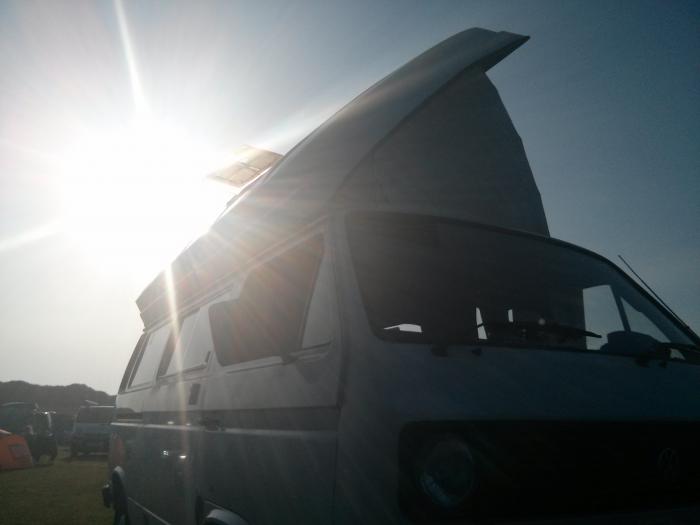
Last weekend we decided we should absolutely not go away camping, as we have loads of life admin to sort out at home. But then some good friends told us that they were off to their favourite campsite on the Gower and that we should join them. With this glorious weather, we knew we’d regret it if we didn’t, so we headed down on the saturday afternoon, haggled our way into a packed site, minimal camping gear (change of clothes, sleeping bags, and a few supplies in the fridge), popped up the roof and was rewarded by an ice cold cider by our generous hosts.
A glorious weekend of socialising, handstand competitions and swimming ensued…
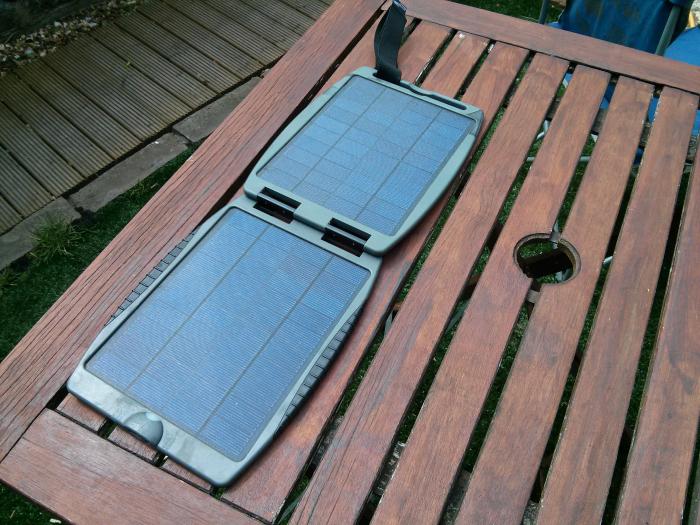
With the recent rare uk heatwave, my mind drifted back to solar panels, and I dug out my solargorilla to see if it is capable of charging my nexus 4 phone directly via USB. Conclusion – yes it does, as long as there are no clouds. During my brief experiment, the phone would switch between “charging” and “please connect your charger”, as clouds obscured the sun. This is an improvement over my old 3gs iPhone, which would always throw its toys out of the pram when the charge dropped, and then not go back to charging, so charging via the powergorilla battery pack (which can be charged from the solargorilla) was the only realistic option. Unfortunately my powergorilla has stopped working altogether now and is out of warranty, which is a shame as it was very useful.
Charging phones and other low power devices really doesn’t make much of a dent in a leisure battery, so I have less need to use a small panel like this. I could use it to top up the van battery (starter or leisure) when it isn’t being driven for long periods of time, but I font think it will be particularly effective.
I really need to stop spending money on our campervan now, but I’m really keen to get myself set up with a decent 80 Watt or bigger solar panel. It would be nice to have something that could keep our 40 watt cool box, laptop, lights, water pump, stereo etc. running long-term away from mains hookup.
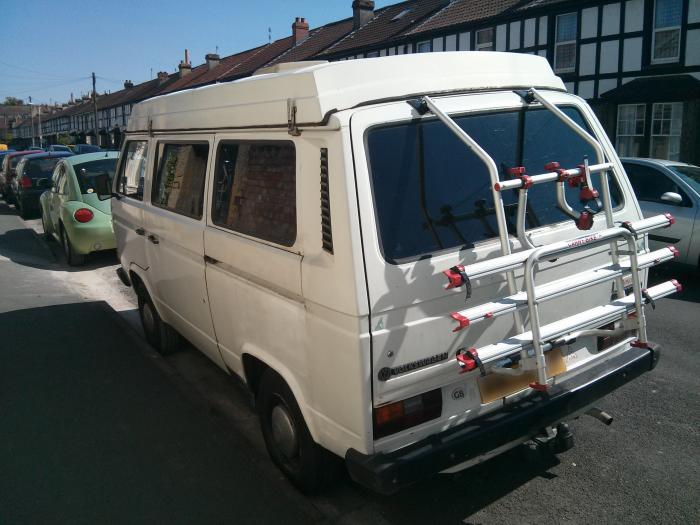
Over the last month or so i’ve continued to add things to Rocky – no actual basket or bells (that’s just a Pink Floyd reference), but I have had the rear windows tinted, added an insurance-approved immobiliser and wired in a reading light and a couple of fans. This is in preparation for an upcoming Europe road trip – just a short one, but hopefully the first of many.
The tinted windows are mainly for privacy, but should also help to keep it cool inside, by filtering out most of the UV light. In conjunction with an extra set of curtains across the back of the front seats, we can now transform the bus into an instant surf changing room, or private office with minimal effort. We’ll still use the thermal mats and curtains to keep the cab private, and no-doubt still use all the thermal mats for winter camping. The tint is known as “limo” – the darkest option only allowing 5% of UV through – we thought if we are going to bother at all, we might aswell make it as private as possible. You can still see out fine. We’ve also kept the original curtains, to help keep it dark inside for sleeping – I added some strong neodymium magnets into the hem, in an attempt to keep them stuck at the bottom, rather than dangling around – I often end up sleeping with my head outside the curtain! This seems to work well and is more elegant than adding a curtain wire retainer.
The immobiliser was added because it seems VW campers are a popular target for thieves, being easier to steal than modern vehicles, and there being a ready second-hand market for vehicles and spares. Hopefully it will bring my next insurance premium down too. I’ll carry on using the steering lock too, mainly as a visual deterrent – belt and braces!

The 12 volt LED reading light will be more efficient and provide a nicer after-dark ambience than the stark white light of the strip lights. It’s also got a flexible stem so can be positioned as a reading light or uplighter.
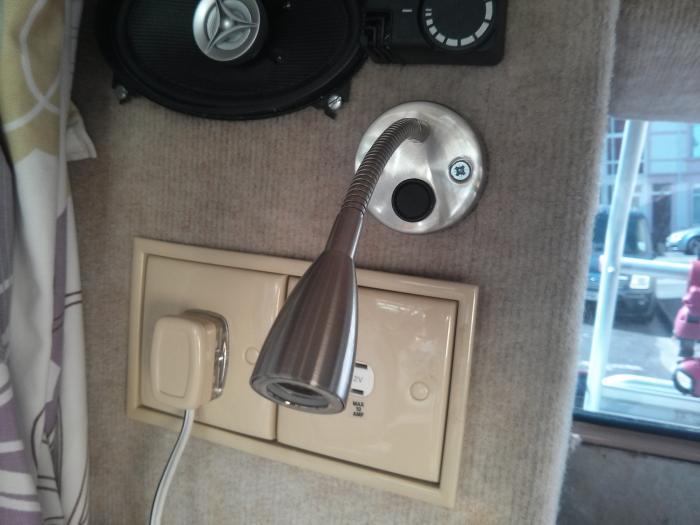
I also permanently mounted a carbon monoxide detector on the wardrobe (not pictured), seemed like a sensible thing to have somewhere where it will be effective (not much use if it’s hidden away at the back of a cupboard).
I’ve stuck a 12 volt steel retro fan in the front, wired into a 12 volt cigar lighter socket splitter, so we can also plug in phone chargers, sat nav etc. One of the things still on my list is to make sure that this 12 volt socket and the stereo is wired into the leisure battery circuit rather than the starter battery, as no doubt these will be running for long periods of time when parked up. I’ve also added another fan in the back above the passenger seat.
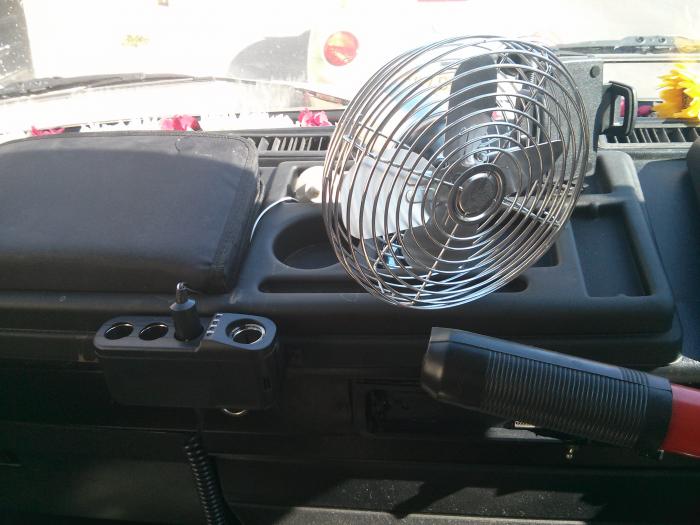
Lastly I added some extra magnet catches to the cupboard doors, which have a habit of flying open when we go around sharp bends and depositing the contents all over the floor (i’ve lost count of the times i’ve ended up with a jar of mixed herbs flying round the floor, threatening to smash!). I then added some handles so we can actually open the doors with the added magnets, without breaking fingernails!
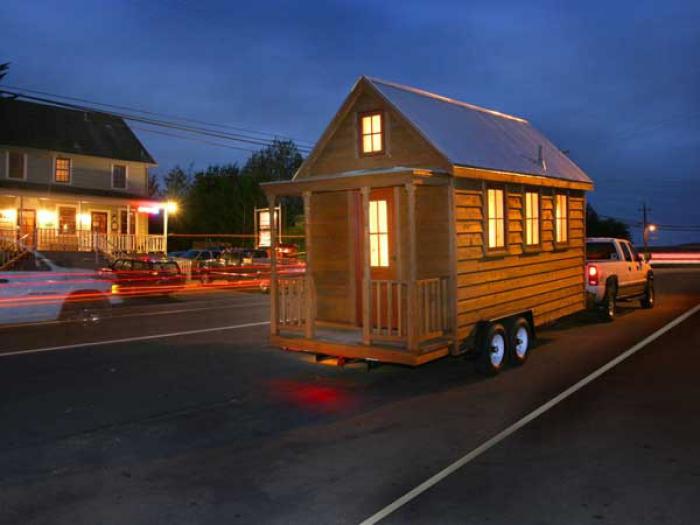
I somehow ended up watching this documentary on youtube: We The Tiny House People, about people building their own homes, most of which are in the form of a kind of log cabin trailer as pictured above. The documentary is well worth a watch if you are looking for ideas about building your own tiny home, or trailer.
Before we got our camper van, I was seriously looking at caravan/ trailers to tow behind our beetle – I think these might be a little large for the bug, and the U.K. roads, but they’re not really intended for touring – more “a home that happens to be mobile”. However, I was also looking into converting our shed into an office, so these little homes are full of ideas of ways to use small space.
If you’re interested in tiny homes, check out the Tiny House Blog. I’ve also found this company in the UK: Tiny House UK. Picture above is from www.tumbleweedhouses.com, where you can download plans, order trailers built to order (in the U.S.) and view more pictures.
Where exactly did June 2013 go?